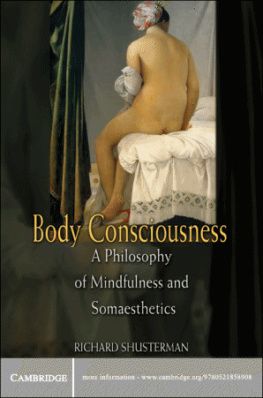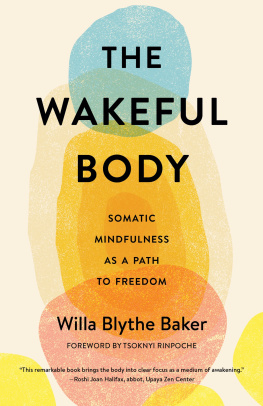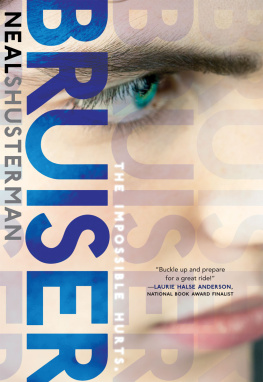Richard Shusterman - Body Consciousness: A Philosophy of Mindfulness and Somaesthetics
Here you can read online Richard Shusterman - Body Consciousness: A Philosophy of Mindfulness and Somaesthetics full text of the book (entire story) in english for free. Download pdf and epub, get meaning, cover and reviews about this ebook. year: 2008, publisher: Cambridge University Press, genre: Religion. Description of the work, (preface) as well as reviews are available. Best literature library LitArk.com created for fans of good reading and offers a wide selection of genres:
Romance novel
Science fiction
Adventure
Detective
Science
History
Home and family
Prose
Art
Politics
Computer
Non-fiction
Religion
Business
Children
Humor
Choose a favorite category and find really read worthwhile books. Enjoy immersion in the world of imagination, feel the emotions of the characters or learn something new for yourself, make an fascinating discovery.
- Book:Body Consciousness: A Philosophy of Mindfulness and Somaesthetics
- Author:
- Publisher:Cambridge University Press
- Genre:
- Year:2008
- Rating:4 / 5
- Favourites:Add to favourites
- Your mark:
- 80
- 1
- 2
- 3
- 4
- 5
Body Consciousness: A Philosophy of Mindfulness and Somaesthetics: summary, description and annotation
We offer to read an annotation, description, summary or preface (depends on what the author of the book "Body Consciousness: A Philosophy of Mindfulness and Somaesthetics" wrote himself). If you haven't found the necessary information about the book — write in the comments, we will try to find it.
Body Consciousness: A Philosophy of Mindfulness and Somaesthetics — read online for free the complete book (whole text) full work
Below is the text of the book, divided by pages. System saving the place of the last page read, allows you to conveniently read the book "Body Consciousness: A Philosophy of Mindfulness and Somaesthetics" online for free, without having to search again every time where you left off. Put a bookmark, and you can go to the page where you finished reading at any time.
Font size:
Interval:
Bookmark:

Body consciousness
Contemporary culture increasingly suffers from problems of attention, overstimulation, and stress. We are plagued by a growing variety of personal and social discontents generated by deceptive body images. This book argues that improved body consciousness can relieve these problems and enhance ones knowledge, performance, and pleasure. The body is our basic medium of perception and action, but focused attention to its feelings and movements has long been criticized as a damaging distraction that also ethically corrupts through self-absorption. In Body Consciousness , Richard Shusterman eloquently refutes such charges by engaging the most influential twentieth-century somatic philosophers and incorporating insights from both Western and Asian disciplines of body-mind awareness. Rather than rehashing intractable ontological debates on the mind-body relation, Shusterman reorients study of this crucial nexus toward a more fruitful, pragmatic direction that reinforces important but neglected connections between philosophy of mind, ethics, politics, and the pervasive aesthetic dimensions of everyday life.
RICHARD SHUSTERMAN is the Dorothy F. Schmidt Eminent Scholar in the Humanities and Professor of Philosophy at Florida Atlantic University, Boca Raton. Educated at Jerusalem and Oxford, he is internationally known for his contributions to philosophy and his pioneering work in somaesthetics, a field of theory and practice devoted to thinking through the body. A recipient of senior Fulbright and National Endowment for the Humanities fellowships, Dr. Shusterman has held academic positions in Paris, Berlin, and Hiroshima and is the author of several books, most recently Surface and Depth and Performing Live . His Pragmatist Aesthetics has been published in thirteen languages.
A Philosophy of Mindfulness and Somaesthetics
Richard Shusterman

Cambridge, New York, Melbourne, Madrid, Cape Town, Singapore, So Paulo, Delhi
Cambridge University Press
32 Avenue of the Americas, New York, NY 10013-2473, USA
www.cambridge.org
Information on this title: www.cambridge.org/9780521858908
Richard Shusterman 2008
This publication is in copyright. Subject to statutory exception
and to the provisions of relevant collective licensing agreements,
no reproduction of any part may take place without
the written permission of Cambridge University Press.
First published in print format 2008
ISBN 978-0-511-39130-9 mobipocket
ISBN 978-0-511-39261-0 eBook (Kindle Edition)
ISBN 978-0-521-85890-8 hardback
ISBN 978-0-521-67587-1 paperback
Cambridge University Press has no responsibility for the persistence or accuracy of URLs for external or third-party Internet Web sites referred to in this publication and does not guarantee that any content on such Web sites is, or will remain, accurate or appropriate.
In memory of J. W. S.,
whose body gave me life, love, and consciousness.
... her pure and eloquent blood,
Spoke in her cheeks and so distinctly wrought,
That one might almost say, her body thought.
She, she, thus richly, and largely housed, is gone.
John Donne, Of the Progress of the Soul: The Second Anniversary
The human body is the best picture of the human soul.
Ludwig Wittgenstein, Philosophical Investigations
The body is to be compared, not to a physical object, but rather to a work of art.
Maurice Merleau-Ponty, The Phenomenology of Perception
Monks, one thing, if practiced and made much of, conduces to great thrill, great profit, great security after the toil, to mindfulness and self-possession, to the winning of knowledge and insight, to pleasant living in this very life, to the realization of the fruit of release by knowledge. What is that one thing? It is mindfulness centered on body.
The Buddha, Anguttara Nikya
Besides, it is a shame to let yourself grow old through neglect before seeing how you can develop the maximum beauty and strength of body; and you cant have this experience if you are negligent, because these things dont normally happen by themselves.
Socrates, from Xenophons Memoirs of Socrates
Contents |
| 1 |
| 2 |
| 3 |
| 4 |
| 5 |
| 6 |
Contemporary culture increasingly suffers from problems of attention, overstimulation, and stress. We are further plagued by a growing variety of personal and social discontents generated by deceptive body images. This book argues that improved body consciousness can help relieve these problems and enhance ones knowledge, performance, and pleasure. If body consciousness is a topic unlikely to comfort conventional philosophical tastes, this is not because philosophy has always ignored the body, as too many somatic advocates are fond of complaining. The body in fact exerts a very powerful (though generally negative) presence in philosophys persistent privileging of mind and spirit. Its dominantly negative image as a prison, distraction, source of error and corruption is both reflected and reinforced by the idealistic bias and disregard for somatic cultivation that Western philosophers generally display.
We must not forget, however, that philosophy in ancient times was practiced as a distinctly embodied way of life in which somatic disciplines frequently formed an important part, even if such disciplines sometimes assumed a more body-punishing character in philosophies where mind and soul were thought to achieve more freedom and power through severe somatic asceticism. Plotinus, for example (according to his admiring biographer Porphyry), was so ashamed of being in the body and so keen to transcend it that he not only drastically limited his diet but even abstained from the use of the bath. Today, when philosophy has shrunk from a global art of living into a narrow field of academic discourse, the body retains a strong presence as a theoretical (and sometimes potently political) abstraction. However, the idea of using its cultivation for heightened consciousness and philosophical insight would probably strike most professional philosophers as an embarrassing aberration. I hope to change this prejudice.
Unlike philosophers, artists have generally devoted a very adoring, revering attention to the body. Realizing how powerfully and precisely our mental life is displayed through bodily expression, they have shown how the most subtle nuances of belief, desire, and feeling are reflected in the postural and gestural attitudes of our figures and facial countenance. However, in their idolizing love of the human body, artists have usually preferred to portray it as the attractive object of another persons consciousness rather than the radiating expression of the somatic subjects own probing consciousness of embodied self.Women, particularly young vulnerable women, are the frequent subjects of such objectification, portrayed as lusciously sensuous and obligingly passive flesh for the viewers devouring delectation. The artistic yearning to glorify the bodys beauty as desired object often results, moreover, in stylistic exaggerations that propagate deceptive images of bodily ease and grace.
Such problems can be detected in the illustration that adorns the cover of this book, the famous Valpinon Bather (1808) of Ingres, one of his series of acclaimed Turkish bath and harem paintings portraying naked odalisques (female slaves or concubines of the harem). The young woman here, passively posed on a luxuriously bedded and curtained interior, is fresh and naked from her bath and thus ready for her required sexual service. She presents a deliciously lovely and luminous backside of flesh. But in her static pose, with her head turned away in darker shadow and her gaze and facial expression invisible, we get no sense of her having any active, thoughtful consciousness at all. She even seems unconscious of the close presence of the implied viewer, who sees her in almost total nakedness, apart from the turban on her bound hair and the sheet wrapped around her arm both more suggestive of her bondage than of protective covering. Ingres, moreover, intensifies the womans visual beauty and erotic charge by putting her in a postural constellation of legs, spine, and head that highlights her figures graceful long limbs and curving lines but that in fact is anatomically far from a posture conducive to comfort, let alone effective action. What a shock to learn that the marketing department had selected this beautiful but painfully misleading image for the cover of my book on body consciousness! As a critic of media cultures deceptive objectifications of the body, but also as a Feldenkrais practitioner sensitive to the strain and suffering of the spine, I voiced my objections but was decisively told that the vast majority of my potential readers would only be attracted to the beauty of the Ingres and never notice its unsightly social and somatic import. If that indeed is true, then this books arguments are all the more needed to open their eyes to other forms and beauties of body consciousness. Do not judge this book by its cover.
Font size:
Interval:
Bookmark:
Similar books «Body Consciousness: A Philosophy of Mindfulness and Somaesthetics»
Look at similar books to Body Consciousness: A Philosophy of Mindfulness and Somaesthetics. We have selected literature similar in name and meaning in the hope of providing readers with more options to find new, interesting, not yet read works.
Discussion, reviews of the book Body Consciousness: A Philosophy of Mindfulness and Somaesthetics and just readers' own opinions. Leave your comments, write what you think about the work, its meaning or the main characters. Specify what exactly you liked and what you didn't like, and why you think so.










